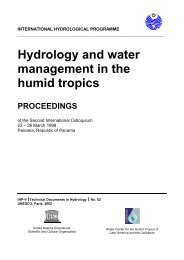FR AB - Science Reference
FR AB - Science Reference
FR AB - Science Reference
Create successful ePaper yourself
Turn your PDF publications into a flip-book with our unique Google optimized e-Paper software.
L. BIBBS ET AL.<br />
one goal of the study was to acquaint member laboratories<br />
with a flexible strategy that could be used for<br />
introduction of a variety of different labels other than<br />
biotin. To make this endeavor especially valuable for<br />
core laboratories, it was suggested that the new<br />
approach, based on utilization of a side-chain protected<br />
lysine residue orthogonal to Fmoc/t-Bu that<br />
employs Rink amide MBHA resin coupled with Fmoc-<br />
Lys(Dde)-OH be used. 2 In this approach, first the<br />
peptide is synthesized, then the label is added for<br />
coupling to the Lys, followed by cleavage and deprotection.<br />
Participating laboratories were asked to submit<br />
the requested peptide without purification. The<br />
PSRG members used amino acid analysis, capillary<br />
electrophoresis, reverse-phase high-performance liquid<br />
chromatography (HPLC), matrix-assisted laser desorption/ionization<br />
time-of-flight mass spectrometry<br />
(MALDI-TOF/MS), and electrospray ionization mass<br />
spectrometry (ESI/MS) to analyze all peptides submitted<br />
from participating laboratories in addition to a<br />
test peptide synthesized by the PSRG in preparation<br />
for the study. In this report, the results from analysis<br />
of the PSRG test peptide and submitted peptides are<br />
presented, and the method used by the PSRG for synthesis<br />
of the test peptide is described.<br />
METHODS<br />
Synthesis of the <strong>Reference</strong> Peptide<br />
For testing by the PSRG, H-Ala-Glu-Gly-Lys-Leu-Arg-<br />
Phe-Lys(biotin)-NH 2 was synthesized on an <strong>AB</strong> 431A<br />
synthesizer (Applied Biosystems, Foster City, CA).<br />
Rink amide MBHA resin was coupled with Fmoc-<br />
Lys(Dde)-OH using HBTU/HOBt/DIEA activation. 3 All<br />
remaining residues except the N-terminal Ala were<br />
incorporated as Fmoc-amino acids with the same activation<br />
chemistry, using Pbf for Arg, Boc for Lys, and<br />
OtBu for Glu as the side-chain protecting groups. The<br />
N-terminal Ala was incorporated as t-Boc-Ala. After<br />
completion of the synthesis, the resin was washed<br />
twice with N,N-dimethylformamide (DMF). The Dde<br />
side-chain protection was removed by treatment with<br />
2% hydrazine (Sigma, St. Louis, MO) in DMF (7 mL/0.1<br />
mmole of the protected peptide resin; 2 times, 5 minutes<br />
each). The resin was then washed 3 times with<br />
DMF followed by 2 washes with DMF:dimethyl sulfoxide<br />
(DMSO; 1:1, v/v). A 10-fold molar excess of<br />
biotin (Aldrich, Milwaukee, WI) was dissolved in 5 mL<br />
of DMF:DMSO (1:1). It was necessary to warm the<br />
mixture and vortex it for several minutes to dissolve<br />
the biotin completely. The biotin solution was then<br />
treated with 2.1 mL of 0.45-M HBTU/HOBt in DMF followed<br />
by 0.3 mL of diisopropylethylamine (DIEA).<br />
The activated biotin solution was added to the resin,<br />
156 JOURNAL OF BIOMOLECULAR TECHNIQUES, VOLUME 11, ISSUE 4, DECEMBER 2000<br />
and the mixture was stirred overnight. The resin was<br />
washed with DMF:DMSO (1:1; 3 times) followed by<br />
dichloromethane:methanol (1:1; 2 times). After the<br />
resin was thoroughly dried, the peptide was cleaved<br />
and deprotected with Reagent-K.<br />
Amino Acid Analysis<br />
Crude peptide samples were hydrolyzed for 24 hours<br />
at 110�C using vapor-phase hydrolysis in 6-N HCl containing<br />
2% saturated phenol/water. The samples were<br />
then analyzed by Waters AccQ*Tag chemistry using a<br />
Waters Alliance HPLC system (Milford, MA) equipped<br />
with a fluorescence detector.<br />
High-Performance Liquid Chromatography<br />
Analyses were conducted on a Waters HPLC system<br />
consisting of two model 600 solvent delivery systems,<br />
a Wisp model 712 automatic injector, a model 490 programmable<br />
wavelength ultraviolet detector, and a DEC<br />
model 860 Networking Computer to control system<br />
operation and collect data. HPLC conditions were as<br />
follows: column, Delta Pak C18 (Waters), 3.9 � 150<br />
mm, 5 �m, 100 Å; buffer A, 0.1% trifluoroacetic acid<br />
(TFA) in water; buffer B, 0.1% TFA in acetonitrile; linear<br />
gradient, 5% B to 60% B in 45 minutes; flow rate,<br />
1.0 mL/minute; detector wavelengths, 220 and 279 nm.<br />
Capillary Electrophoresis<br />
Peptides were analyzed on a PACE-MDQ CE system<br />
(Beckman Instruments, Palo Alto, CA) using an aminecoated<br />
capillary and acetate buffer, pH 4.5. The capillary<br />
was preconditioned with an amine regenerator<br />
and a buffer rinse. Samples were applied by a 5-second<br />
pressure injection (2 psi) and separated at 30 kV<br />
for 10 minutes using reversed polarity.<br />
Electrospray Ionization Mass Spectrometry<br />
ESI/MS analyses were conducted on a ThermoFinnigan<br />
LCQ ion trap mass spectrometer (San Jose, CA).<br />
Samples were dissolved in 1 mL of water and diluted<br />
at least 100-fold in 70% aqueous acetonitrile/0.5%<br />
acetic acid. Peptide samples were introduced into the<br />
electrospray interface by flow injection at a rate of<br />
5 �L/minute. MS conditions were as follows: capillary<br />
temperature, 200�C; spray voltage, 5 kV; capillary voltage,<br />
30 V; tube lens offset, 18 V; sheath gas, 30 L/min.<br />
For MS n , the relative collision energy was 35%. Spectral<br />
averaging for 10 scans was used prior to data<br />
acquisition.















